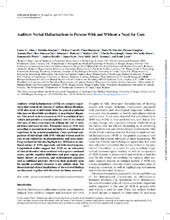| dc.contributor.author | Johns, Louise C. | |
| dc.contributor.author | Kompus, Kristiina | |
| dc.contributor.author | Connell, Melissa | |
| dc.contributor.author | Humpston, Clara | |
| dc.contributor.author | Lincoln, Tania M. | |
| dc.contributor.author | Longden, Eleanor | |
| dc.contributor.author | Preti, Antonio | |
| dc.contributor.author | Alderson-Day, Ben | |
| dc.contributor.author | Badcock, Johanna C. | |
| dc.contributor.author | Cella, Matteo | |
| dc.contributor.author | Fernyhough, Charles | |
| dc.contributor.author | McCarthy-Jones, Simon | |
| dc.contributor.author | Peters, Emmanuelle | |
| dc.contributor.author | Raballo, Andrea | |
| dc.contributor.author | Scott, James | |
| dc.contributor.author | Siddi, Sara | |
| dc.contributor.author | Sommer, Iris E. | |
| dc.contributor.author | Larøi, Frank | |
| dc.date.accessioned | 2015-05-15T12:09:30Z | |
| dc.date.available | 2015-05-15T12:09:30Z | |
| dc.date.issued | 2014 | eng |
| dc.identifier.issn | 0586-7614 | |
| dc.identifier.uri | https://hdl.handle.net/1956/9886 | |
| dc.description.abstract | Auditory verbal hallucinations (AVH) are complex experiences that occur in the context of various clinical disorders. AVH also occur in individuals from the general population who have no identifiable psychiatric or neurological diagnoses. This article reviews research on AVH in nonclinical individuals and provides a cross-disciplinary view of the clinical relevance of these experiences in defining the risk of mental illness and need for care. Prevalence rates of AVH vary according to measurement tool and indicate a continuum of experience in the general population. Cross-sectional comparisons of individuals with AVH with and without need for care reveal similarities in phenomenology and some underlying mechanisms but also highlight key differences in emotional valence of AVH, appraisals, and behavioral response. Longitudinal studies suggest that AVH are an antecedent of clinical disorders when combined with negative emotional states, specific cognitive difficulties and poor coping, plus family history of psychosis, and environmental exposures such as childhood adversity. However, their predictive value for specific psychiatric disorders is not entirely clear. The theoretical and clinical implications of the reviewed findings are discussed, together with directions for future research. | en_US |
| dc.language.iso | eng | eng |
| dc.publisher | Oxford University Press | eng |
| dc.rights | Attribution CC BY | eng |
| dc.rights.uri | http://creativecommons.org/licenses/by/3.0/ | eng |
| dc.title | Auditory verbal hallucinations in persons with and without a need for care | eng |
| dc.type | Peer reviewed | |
| dc.type | Journal article | |
| dc.date.updated | 2015-04-08T13:03:31Z | en_US |
| dc.description.version | publishedVersion | |
| dc.rights.holder | Copyright 2014 The Authors | |
| dc.identifier.doi | https://doi.org/10.1093/schbul/sbu005 | |
| dc.identifier.cristin | 1150524 | |
| dc.source.journal | Schizophrenia Bulletin | |
| dc.source.40 | 40 | |
| dc.source.14 | Suppl 4 | |
| dc.source.pagenumber | S255-S264 | |
| dc.subject.nsi | VDP::Social sciences: 200::Psychology: 260::Biological psychology: 261 | eng |
| dc.subject.nsi | VDP::Medical sciences: 700::Clinical medical sciences: 750::Psychiatry, child psychiatry: 757 | eng |
| dc.subject.nsi | VDP::Samfunnsvitenskap: 200::Psykologi: 260::Biologisk psykologi: 261 | nob |
| dc.subject.nsi | VDP::Medisinske fag: 700::Klinisk medisinske fag: 750::Psykiatri, barnepsykiatri: 757 | nob |

